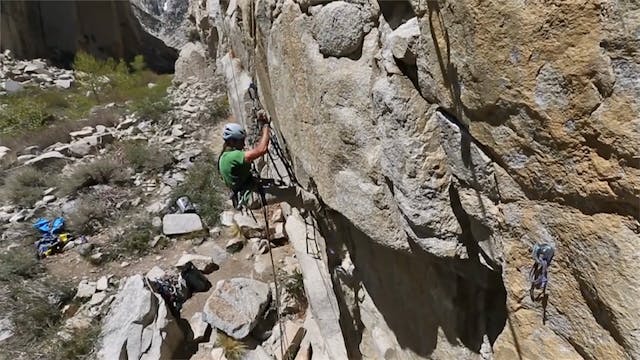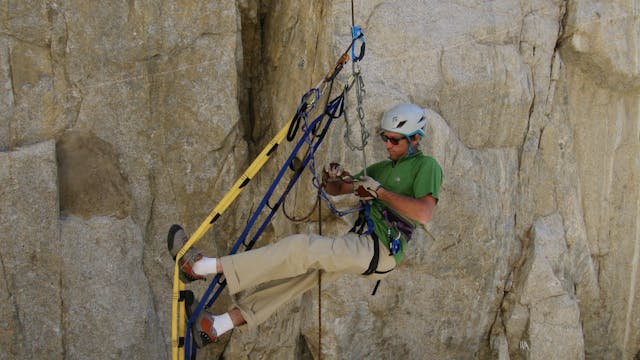Aid Climbing: 6. Jumaring Basics
Aid Climbing & Big Walls
•
6m 0s
In this video we examine the basics of jumaring. Jumaring, or “jugging”, is a means of ascending a fixed rope, which in aid climbing is done to either clean a pitch or simply ascend to a previous established highpoint.
First, adjust the length of your daisy chain to match your arm’s reach on your upper jumar. Second, clip your aiders into the locking carabiner that attaches your harness to your jumar via the daisy chain.
You can refer to previous CTT videos on the proper way to set up daisy chains.
When cleaning a pitch or ascending a fixed line, you’ll usually need 2 ascenders. It is important to have another device or system to further back yourself up and keep you on the rope if the jumars were to pop off (which is rare but can definitely happen). This could be a GriGri, or simply knots on a bight tied at intervals as you jug the line. We will cover this in more detail in our video on “Backups for Jumaring and Cleaning”[hyperlink to video].
There are 4 levels of difficulty when it comes to jumaring:
Level 1: Ascending a rope hanging plumb is quite easy, once you get used to the awkward movements.
Level 2: Cleaning a pitch where the rope is clipped through the leader’s gear is a little more complicated.
Level 3: When a pitch angles right or left, jumaring is more challenging.
Level 4: Cleaning a fully traversing pitch is the most technically difficult of all.
Below are the the steps for setting up a standard jumaring system:
Step 1: Attach the first jumar to the fixed rope by opening the cam, sliding it onto the rope, and closing it.
Step 2: Attach the second jumar to the fixed rope, just below the first.
Step 3: Clip the first daisy chain to the upper jumar using a locking carabiner. Choose the right loop by measuring your arm’s reach when hanging on the rope. Your arm should have a slight bend at the elbow when the daisy is taught on the top jug.
Step 4: Attach the second daisy chain to the lower jumar also using a locking carabiner. The distance here is not as important, and a little longer is okay.
Step 5: Clip each aider (ladder) to their respective jumar by clipping the non locking carabiner into the same locking carabiner that connects each daisy chain to the jumar.
Below are the steps to begin jumaring (assuming your right hand is the dominate hand):
Step 1: Step into the ladder connected to the lower jumar with your left foot, and grab onto the lower jumar with your left hand.
Step 2: Weight the lower jumar by standing up on your left leg, and slide the upper jumar upward with your right hand. Note that the jumar will only slide upward when it is un-weighted.
Step 3: Sit so that your body weight is on the daisy chain of the upper jumar, and then place your right foot into a step of the ladder connected to the upper jumar.
Step 4: Weight the upper jumar by standing up on your right leg, and slide the lower jumar to meet the upper jumar.
Repeat steps 2 and 4 to continue jumaring the fixed line.
Since the two jumars are your only attachment points to the line, it’s important to back them up and ensure they are secure:
1. Tie a backup knot in the rope by tying a an overhand or figure 8 on a bight (below the jumars), and clipping the knot into the belay loop of your harness with a locking carabiner. Repeat this process every 10-15 feet as you continue to ascend the rope.
2. Secure the jumars to the rope by clipping a locking (or nonlocking) carabiner through the uppermost hole in the device AND around the rope. Note that the teeth of the jumar could still potentially become dis-engaged or slip, but the jug will remain attached to the rope and if both jugs failed, the knots clipped to your belay loop will serve as “stopper” knots.
We hope you found this video helpful. Feel free to comment below with questions or thoughts!
Please remember, climbing is inherently dangerous. Climb at your own risk.
Up Next in Aid Climbing & Big Walls
-
Aid Climbing: 7. Jumaring Over Edges ...
While jugging a pitch, you will likely encounter numerous obstacles. Roofs and protruding edges are examples.
When jugging through a roof, it’s important to place your jugs just past or just before the edge—as opposed to stopping directly on it.
Step 1: Approach the edge and stop just short...
-
Aid Climbing: 8. Jumaring Texas Style
In this video we look at another jumaring technique known as the Texas style (aka frog or double leg style). Texas style jumaring is a useful technique for ascending a free hanging line because it allows the climber to get all their power into the lower jumar, in order to slide the upper jumar.
... -
Aid Climbing: 9. Backups for Jumaring...
In this video we review options for backing yourself up when jumaring and cleaning an aid climb. Backing yourself up when jumaring is a basic necessity for aid climbing survival. Different climbers have different styles—it is simply a matter of preference and application.
The idea with these v...


